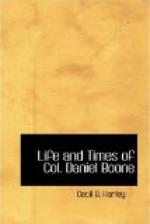“The class of hunters with whom I was best acquainted, were those whose hunting ranges were on the eastern side of the river, and at the distance of eight or nine miles from it. As soon as the leaves were pretty well down, and the weather became rainy, accompanied with light snows, these men, after acting the part of husbandmen, so far as the state of warfare permitted them to do so, soon began to feel that they were hunters. They became uneasy at home. Every thing about them became disagreeable. The house was too warm. The feather-bed too soft, and even the good wife was not thought, for the time being, a proper companion. The mind of the hunter was wholly occupied with the camp and chase.
“I have often seen them get up early in the morning at this season, walk hastily out, and look anxiously to the woods and snuff the autumnal winds with the highest rapture, then return into the house and cast a quick and attentive look at the rifle, which was always suspended to a joist by a couple of buck horns, or little forks. His hunting dog, understanding the intentions of his master, would wag his tail, and by every blandishment in his power express his readiness to accompany him to the woods.
“A day was soon appointed for the march of the little cavalcade to the camp. Two or three horses furnished with pack-saddles were loaded with flour, Indian meal, blankets, and every thing else requisite for the use of the hunter.
“A hunting camp, or what was called a half-faced cabin, was of the following form; the back part of it was sometimes a large log; at the distance of eight or ten feet from this, two stakes were set in the ground a few inches apart, and at the distance of eight or ten feet from these, two more, to receive the ends of the poles for the sides of the camp. The whole slope of the roof, was from the front to the back. The covering was made of slabs, skins, or blankets, or, if in the spring of the year, the bark of hickory or ash trees. The front was entirely open. The fire was built directly before this opening. The cracks between the logs were filled with moss. Dry leaves served for a bed. It is thus that a couple of men, in a few hours will construct for themselves a temporary, but tolerably comfortable defense, from the inclemencies of the weather. The beaver, otter, muskrat and squirrel are scarcely their equals in dispatch in fabricating for themselves a covert from the tempest!
“A little more pains would have made a hunting camp a defense against the Indians. A cabin ten feet square, bullet proof, and furnished with port-holes would have enabled two or three hunters to hold twenty Indians at bay for any length of time. But this precaution I believe was never attended to; hence the hunters were often surprised and killed in their camps.
“The site for the camp was selected with all the sagacity of the woodsman, so as to have it sheltered by the surrounding hills from every wind, but more especially from those of the north and west.




